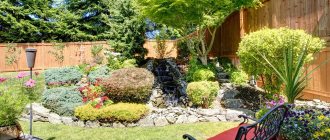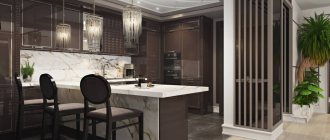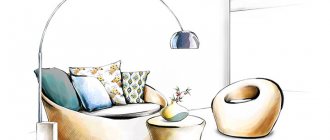The layout of a personal plot is the most important point in the construction of cottages and country houses. Currently, more and more developers prefer not to engage in active cultivation of agricultural crops and leave only a small piece of land for growing fruitful plants. But what to do with the rest of the site?
Layout and landscape design of a yard in a private house
In order for a country house not to look lonely and dull, it is necessary to take a very responsible approach to creating the layout of the site of a private house, as well as to its design.
Backyard Makeup Ideas
After reviewing the basic rules of landscape design, move on to landscaping the space. Check out the ideas below for landscaping your backyard.
Replace obsolete materials
For this purpose, solid concrete with brick strips is now often used. Make a patio area with concrete, add white sand and add a fountain for dramatic effect.
Enlarge your patio area
A common backyard mistake is making the patio too small. When you're working on your backyard makeover, consider extending the patio to accommodate larger furniture and provide walking around the space.
Patio is a useful yard decoration
Re-paving
Plain gray concrete can be quite boring. Transform your backyard pavers to transform the feel of your entire area. When redoing paving slabs, you have two options: remove the existing sidewalk or transform what you have. Create stains and etchings on the concrete path to make it look like natural stone. If you want to remodel your existing paving, you'll save money on materials and labor.
Low cost garden paths
Don't let small or awkward spaces limit you
Tight spaces can be a challenge and often end up going unused. However, you can transform a narrow space into a backyard fully equipped for outdoor activities. Creative layout and space-saving techniques can be used to fit more features into a small or awkward backyard.
DIY your backyard
You can remodel your backyard yourself, without professionals and their resources, if the matter is limited to feasible work. However, this does not include demolition and installation of new small architectural forms, as this work will take the average homeowner weeks to complete, while a team of professionals can do it in a few days.
Lots of ideas for creating beauty
Projects that involve installing running water, gas, or electrical lines may be additionally complicated. If you want a fountain, a built-in grill, or lots of lighting, it's best to hire a licensed professional. However, when choosing a DIY option that will save you some money, consider planting your own plants. If Make sure you know the requirements for each plant to choose the best location. Consider also installing a patio area yourself.
Small architectural forms, decor
The decor is selected based on the style of the landscape. It is made of wood, ceramics, stone, concrete, plastic, rattan, wire, etc.
What does this include:
- benches;
- garden lights;
- decorative wells;
- miniature fountains;
- sculptural compositions;
- swing;
- doghouse;
- birdhouse;
- flower pots;
- arches;
- bridges;
- forged trellises;
- flowerpot;
- urns.
Many amateurs create decor on their own, from scrap materials - old tires, plastic bottles, driftwood, stones, fragments of old furniture and household appliances. The children's playground, in addition to ladders and swings, is decorated with colored garden gnomes, ducklings, frogs, mushrooms, the paths are sprinkled with colored stone chips and gravel. The place intended for relaxation is decorated with an artificial pond with a waterfall, a bridge, and a grill or barbecue with suitable furniture is placed on the terrace. Weather vanes, signs, and mailboxes will complement the space at the front entrance in an original way.
Patio Design Ideas
Patios are all about outdoor living. You'll likely spend many hours with friends and family on your patio. Instead of purchasing a large home, many people are looking to expand their outdoor living space. The result is a larger, more luxurious and more secure patio area.
Outdoor patios have become hubs of activity, focused on entertainment and relaxation. A well-designed patio will not only add additional living space to your home, but will also increase its resale value.
Organization of a recreation area
Since your patio will provide the foundation for your outdoor living space, it should be durable, well-constructed. There are a variety of patio and paving materials to choose from. Determine what size, shape and style of patio best suits your needs. Use the information here to start collecting ideas for your new patio.
It's time to stop thinking of your patio as just a place to spend time outdoors. It can serve as a hub for a variety of functions including dining, cooking, socializing and relaxation. The style of your patio will change depending on what features you want to accommodate.
Minuses
If we talk about disadvantages, such plots, of course, have them, among them:
- Inability to build your dream home. The narrow dimensions of the plot do not always allow you to build exactly the house you wanted.
- Lack of tall trees. In narrow areas, regardless of their length, you will have to abandon large trees, since their crown will shade the area and visually make it even smaller.
- Inability to isolate yourself from neighbors and the road. It is not recommended to install a blind fence around the perimeter of a narrow area.
- Additional expenses for arrangement. Narrow areas are considered difficult to work with. Without skills or special education, it is unlikely that you will be able to improve the territory. Therefore, you will have to hire professional landscape designers.
Concrete patios
The durability and versatility of concrete makes it an excellent choice for paving your patio. A concrete patio has many advantages compared to corrugated sheets and other surfaces.
Concrete patio in the courtyard interior
Benefits of concrete patios:
- Highly durable.
- Low operating costs.
- Adaptable to any style.
- Can be poured into any shape.
Decor options:
- Colored concrete. There are several ways to paint concrete, including contrasting, integrating, solid and liquid painting methods (used in combination with embossing), and full staining.
- Embossed Concrete – The surface of your concrete patio can be stamped to create a texture that mimics stone, brick or other materials.
Embossed colored concrete to look like stone
If you already have a patio that is cracked or dirty, you can clean it with concrete. Concrete sanding will make your patio look like new. A reclaimed concrete patio can be painted and stamped.
Another strong trend is to integrate plants into areas where expansion joints would otherwise be located. They help create a more breathable surface and break up the vast structure with greenery. It is not uncommon to use artificial turf in these areas, especially in areas where moisture needs to be maintained.
Grass between seams to maintain moisture
Are concrete patios susceptible to cracking?
Concrete is good for warm climate landscapes that do not experience the extreme freeze-thaw cycles of northern regions that cause uncontrolled cracking. Other factors can also lead to cracking.
This will be of interest to you: Do-it-yourself landscape design for the garden (185+ Photos). Styles You Should Know About
Swimming pond
Swimming pools in the country are also popular bodies of water. You can make a similar pond in your country house with your own hands. They serve not only as a decorative element, but also allow you to relax, cool off and swim.
This can be a very shallow and small pool; it is suitable for children. Or a full-fledged pond for adults. It all depends on the size of the plot and your capabilities. But remember that such a pond will require constant cleaning and special winter care. Also read about the compost bin.
Ideas for gazebos
Gazebos and other shade structures are another way to enjoy nature even if the conditions outside are not the best. During the hot summer, you can relax and have fun outdoors without getting sunstroke. Shade structures also extend the season into fall and winter. If your structure is built with a solid roof or even insulated walls, you can enjoy calm winter mornings while sipping tea without the worry of rain or snow.
Cozy gazebo for summer relaxation
Types of shadow buildings
Gazebos are a self-contained structure, organically placed in the landscape. They can stand on a path and define a space for a walk, or they can define a patio area or outdoor entertaining space. A pergola usually has open sides and a slatted or solid roof.
Pergolas in landscape design
Patio structures are similar to pergolas, except they are attached to the house. This can be an advantage because the patio area can use the house for support and therefore can cost less than a freestanding structure.
Octagonal-shaped gazebos with a durable roof are most often used in traditional gardening areas. They can be an attractive addition if the style of the surrounding landscape works with the structure.
Traditional garden and park area
A canvas canopy is a modern way to get relief from the sun. The fabric is stretched through specially designed posts to accent and cover a seating area or patio. A canvas canopy looks great with the straight lines and simple geometries used in modern homes, and does double duty as a decorative and artistic part of the landscape.
Canopy for gazebo
A screened deck is built right next to the home, usually at the back door for easy access. Instead of glass windows, it has large screens to keep out insects. A screened terrace is great for dining as you get quality time outdoors without any uninvited guests.
A sun room is also being built right next to the house. Because it can be fully insulated and built with two-pane windows, it is a four-season structure that acts as an addition to your home. The sunroom is completely weatherproof, so you can watch birds and wildlife in comfort, even in winter. What really sets a sunroom apart from the rest of your home is that it has lots of windows that enhance outside views.
Features of planning and zoning
It is recommended to divide a narrow land plot into three main zones:
- residential is a place for a home, a children’s or sports ground, a swimming pool;
- garden - here they set up a vegetable garden and a garden;
- household - here they build a shed for tools or keeping animals, a garage, a shower with toilet, etc.
The house is located along or across the dacha plot - as it will be more convenient for those living or vacationing in it. Communications - electricity, heating, gas supply, water supply, sewerage are designed in advance, based on the location of the home and other buildings.
Even if the land is completely fenced with a solid stone fence, a more elegant design is made near the entrance - wrought-iron grilles, perforated wooden gates, etc.
Location of the house
The main element of the plan is a residential building, the location of which usually begins with determination. The ideal orientation of the ends is west-east, so the building will receive a lot of daylight, warming up well in the sun. When the landholding is tiny, occupying a couple of acres, the building is built along the entire plot, the exit is made directly from the rooms. In a “carriage” type house, the rooms, except for the end ones, will be walk-through. It is undesirable to make a building less than five to six meters wide - this is very inconvenient for life. The building is often made two-story or with attics, and a sauna, gym or cellar is equipped in the basement.
Zoning of the site
When zoning, you should make the most of every corner of the plot - even the most non-functional, one with complex terrain, etc. On a large landholding it is easy to place both main and additional, optional zones, but if the plot is very small, then you will have to give up a lot or something combine with something. It is recommended to place the garden with a vegetable garden on the sunny side, while the barn, garage, toilet, and animal premises should be located in the shade.
Mandatory zones
The following areas are mandatory:
- representative or front zone - located near the entrance to the home. There are alpine slides and fountains, vertical and ordinary flower beds, preferably asymmetrical. This is the “face” of land ownership, therefore very careful care is required for the front area;
- private zone - separated from the previous one by trellises and pergolas, curtains and a low fence. These structures in an elongated area are made low, when the zones are separated with the help of flowering plants; white-yellow, pink, and light blue shades are preferred. Inside the private corner there is a gazebo, a terrace, a green office, and a hammock;
- a specialized or economic zone is fenced off just like everyone else. Here they place sheds for equipment, enclosures for animals, hang clotheslines, etc.;
- transit or buffer - arranged if necessary, located closer to the exit from the site, but not in the middle. Here they park a car, motorcycle, bicycle, install water and light meters so as not to let strangers into the house. Also, if necessary, brought construction materials are unloaded here. The buffer is separated from the rest of the space by a taller hedge, wooden or brick fence.
Optional zones
Optional ones include:
- sports ground - most often it is placed between a specialized area and a recreation area;
- children's playground - set up next to the place where adults relax, separated by a symbolic flowerbed or path so that children are always in sight;
- vegetable garden - usually adjacent to the economic zone, separated from it by a hedge or a miniature fence.
Terrace decoration
No matter what size backyard you have, you can make the most of the available space and live the dream. Here are some easy DIY landscaping ideas to create a great outdoor space that you can enjoy day and night.
Customize your space with decking
There's nothing like a new deck to transform your backyard into an outdoor living room or a great party spot. It's an easy, affordable way to expand your living space that will last for many years, and with a little know-how, you can build it yourself.
Terrace - a room with flooring
There are several options for decking materials. In addition to traditional wood flooring, there is an eco-friendly alternative. Composite decking can be made from recycled plastic, which is durable, easy to install and maintain, and resistant to rot and pests.
Build with beams
Beams made from environmentally friendly material
You can shape your backyard to any size and give it a natural, earthy look with treated pine beams. Treated pine beams are resistant to decay, fungus and pests, making them one of the most versatile, easy-to-use and hard-wearing landscaping materials on the market. They can be used to create a retaining wall, stepped garden, flower bed or as a border along your beds.
Space with retaining walls
Retaining walls are a great way to create interesting steps for your backyard design. You can use them to create a raised garden to surround your entertaining space or create a quiet corner to unwind. Retaining walls are also a good way to level out areas of sloping block and add extra space for the kids to play or for you to entertain. Depending on the look you want, retaining walls can be made from logs or treated pine sleepers. Use specially formulated wall holding materials that are interlocking, durable and come in a range of colors.
Own paving
You can add real definition to your backyard and create a great look with pavers. Plus, it will be an easy project that you can do yourself. Pavers make a solid base for your outdoor entertaining area, or you can create a path through your garden. There are a variety of colors and installation designs on the market to suit any backyard, from concrete textured pavers, panel pavers, and sand pavers.
Simple and convenient covering for the yard
Add color and texture with pebbles
Pebbles are an easy way to bring different colors and textures to your backyard. You can use it to fill empty spaces in garden beds or as a ground cover to complement a paved or decked area.
For a purely decorative look, you can use pebbles to create a border or landscape path. There are many colors and styles to choose from in white, blue, orange, red, green, lime, silver or gold. Using the same colored pebbles, you can create solid colored areas or mix colors to create a brighter look.
Bright flowerbed using pebbles
Stylistic directions for a narrow area
The style of the landscape depends on the area of land ownership, the personal preferences of its owners, the most popular:
- minimalism - there are very few details, which is convenient for small plots. The buildings are only necessary; instead of lush flower beds and trees, there are neatly trimmed lawns and bushes. Volumetric embankments, smooth paths, straight trellises for climbing plants are allowed;
- hi-tech - a lot of metal, glass, mirror elements. Gray steel fence and chrome furniture in the sitting area, mirror. Repeating the outline of a small pond, framing the flower beds with borders painted with silver paint;
- eastern - low bushes and trees, alpine slides with many stones and pagoda gazebos. Smooth lines, rounded ponds, ornamental plants from China and Japan, and low wicker furniture are welcome. Symmetry and right angles are completely absent;
- English - perennial plants of different heights predominate here, winding paths paved with coarse gravel or tiles. Reservoirs, practically indistinguishable from those found in the wild, are organically combined with flower beds and carpets;
- country - the beds are located almost chaotically, pumpkins and peppers grow in the flowerbeds, and flowers - wherever necessary. Stylized crane wells, wooden wheels and carts, and fragments of fences woven from wicker are used as decoration;
- Baroque - suitable only for spacious areas. Lush rose bushes and openwork gazebos with columns, antique sculptures and decorative fountains. Forged garden furniture and gilded elements create the most luxurious design;
- forest - only natural materials are used, forest trees, mossy stones. Wooden buildings and beds are made inconspicuous. The land tenure resembles a plot of real forest, with small accents - the redevelopment here is very minimal.
Front yard landscaping
When it comes to decorating your front yard, you'll want to think about what features of your home will be highlighted, as well as how you can transform it into an outdoor space that gets lots of use. If you want to spend your holiday time there, privacy will be key. Privacy can be created with a wall or hedge.
Get a new perspective
Before choosing a project, look at your landscape with fresh eyes and a broader perspective. We are so accustomed to our landscape that it can be difficult to determine what others might see. There are two simple tricks to see the landscape from a new perspective. With both of these methods, the goal is to forget what you think about your landscape and instead look at what actually exists.
The first is an old artist's trick. Get far enough away from your landscape that you can see everything at once. Then squint your eyes until the picture blurs and try to clear your memory.
“Paint” your picture to create a landscape
There may be areas that, when viewed blurredly, appear dark and overgrown. Some areas may look messy because there are too many small plantings, statues or pots. Or, you may have an area that is bright and clean, but a little too empty. All these ideas can give you a general idea of which projects to tackle first.
The second technique you can use to see your landscape with new eyes is to take black and white photographs of your landscaping. By adding color, you can make a familiar space feel new, so you see it with objective eyes. Nowadays, most digital cameras have a black and white setting, so this is easy to do even if you are not a techno genius.
Define boundaries and add mulch
Clean edges deceive the eye, creating a neat and well-kept landscape. If the lawn has encroached into the garden beds and created an uneven line, defining a boundary can improve the appearance of the entire landscape.
Start by laying out a garden hose to define the new boundary. Don't make the beginner mistake of creating a wavy "drunk snake" line. Instead, make wide curves that are scaled to the size of your home. Then use a hoe to cut the grass until you have a clean, attractive line.
Define a beautiful mulch line
Once you've established a neat border, add a layer of wood chip mulch for a sophisticated look. The bright color is attractive, smoothes out uneven soil surfaces and generally gives landscaping a professional finish.
Trim huge bushes
If the plant is clearly not intended to be a hedge, then it needs to be pruned. Otherwise, it will feel like the service is out of control.
Prune the shrub at the base, removing any branches that are within 6 inches of the ground. This gives a more open look and works wonders on Rhododendrons and other shrubs that can appear gloomy and overwhelming when sprawled across the ground.
Neat bushes in the yard of the house
Another good task is to carefully trim any plant that touches the house. Plants that lean against your home can cause paint cracking, as well as mold and ants. Trimming plants 20 to 30cm from the house will give the landscaping a more open look and also give you the opportunity to clean the house or paint it if necessary.
Advantages and disadvantages of a narrow section
A piece of land less than 15 meters wide is not a very successful, but very common layout, which has its pros and cons.
Positive sides:
- lower cost than a square plot of land;
- convenient zoning of space. Example: on one side there is a garden and vegetable garden, in the middle there is a house, behind it there is a garage and outbuildings;
- the design of a house with a smaller width includes large attic windows;
- a single-flight ladder along the wall will originally complement the facade, decorating it;
- If you decide to set up a vegetable garden, it’s easy to make it inconspicuous.
Negative points:
- it is problematic to accommodate a wide, square house, and a very narrow one will have to be well insulated, since it freezes more strongly;
- neighboring houses are located too close, they can shade part of the site, a lower building;
- difficulties with placing a garage - close to the house it will disrupt the composition of the yard, and if located far away, the road to it will take up a lot of usable space;
- a narrow garden in which it is impossible to plant trees that are too tall - they will shade the garden;
- when the site is located near the road, problems with high-quality sound insulation are possible.
To keep the house from being completely cramped, small-width furniture is used, as well as built-in furniture.
Trees
The key quality when choosing a tree for your front yard should be its discreet appeal. The right tree can transform a front yard, adding structural interest, seasonal color, shade and dimension. The best tree choice for your front yard depends on factors including your climate, the space you have, preferences, and the orientation of your landscape.
Trees for small spaces
When choosing a tree for a small front yard, look for a specimen that will create a focal point without dominating your home or landscape. There are many small or dwarf tree varieties that will not grow taller than 8 meters, but have eye-catching features that more than make up for their lack of height, such as interesting leaf shapes and unique branch directions. Good options include dogwoods, Japanese maples, cherry trees and purple plum trees.
Decorative trees for small spaces
Blooming
Flowering trees will give your front yard a welcome splash of color after a long winter, often before the rest of the landscape comes to life. The effect will be similar to the shape of a vase full of flowers, providing a temporary but vibrant splash of color and an intoxicating aroma. Many flowering trees also provide multi-season interest, producing colorful berries and vibrant fall foliage such as flowering cherry trees, myrtle, apple trees and eastern redbells.
Shadow
Planting trees for shade in front of your home can block the harsh morning and afternoon sun from pouring into your windows, keeping your home cooler throughout the summer. Their dense canopies of leaves also slow the evaporation of water from lawns and garden beds. Shade trees come in many shapes and sizes, but fast-growing varieties deliver their benefits sooner. Examples include red maple, oak, poplar, birch, and ash.
Slender birch tree on the site near the house
For autumn foliage
Every front yard should have at least one tree that provides dazzling fall color, with leaves that turn seemingly overnight into brilliant shades of yellow, orange, red or purple. Some trees, such as the sugar maple, will produce a kaleidoscope of colors, ranging from yellow to orange and finally to red.
Evergreens
While many deciduous trees will reward you with spring flowers and fall color, their glory often fades in the winter after the leaves have fallen, leaving you with a lifeless landscape. Almost any front yard can benefit from the year-round color and sculptural beauty of conifers.
Fire bowl
Every modern backyard must have a fire pit, where a large group can gather, chat, barbecue or roast marshmallows. It won’t be difficult to create such a corner, but it’s hard to put into words how much good mood it will bring.
To create a fire bowl, you need to purchase the bowl itself and chairs and curved benches in the store. You don’t have to buy benches; you can build them yourself using several meters of iron mesh and medium-sized stones. Such improvised “benches” will not leave anyone on the sidelines.
Wooden arches
Wooden arches are rightfully considered traditional. Combinations of different types of wood allow you to create very beautiful designs. They are quite easy to decorate, and the cost of the finished product is very low.
The disadvantage of wooden arches is their fragility. In addition, they are light in weight, which is why they can sway from gusts of strong wind. Measures must be taken regularly to prevent wood from rotting.
Landscaping of arches
To garden the arches, you can plant climbing perennials near them. Thanks to their vines, the arch will quickly be filled with fancy green curls. Plants located on arches will grow much better than on the ground.
In addition, a garden arch for climbing plants will make caring for them easier. The ideal choice for decorating arches are:
- climbing rose;
- sweet pea;
- Schisandra chinensis;
- clematis;
- hop;
- grape;
- honeysuckle.
Garden arches are a very attractive element for landscape design. With their help they decorate the garden and give it a mysterious atmosphere.
You should not deprive yourself of such decor. There are a huge number of types of arches. They can be free-standing or part of some kind of structure.
If you wish, you can always find a suitable model on sale. If there is nothing suitable there, then you can make the arch yourself or order its production from specialists.
The main thing when developing a design is not to be afraid to improvise. To get some inspiration, you can look at photos of arches in the garden.
How to arrange a patio, project options with photos
When talking about the design of a patio, we, of course, do not mean flower beds and planting fruit trees, but a stylish arrangement of a place for family recreation in the open air. It is important that it be especially comfortable, cozy, beautiful, and at the same time fit harmoniously into the landscape. All elements of the patio arrangement should be combined with the style of the house and complement each other.
The design of a country patio should begin with a design project: zoning, drawing up a diagram of the location of small garden architectural forms, decorative compositions and ponds, laying out a network of paths, as well as choosing a suitable landscaping style. Ideally, this is done during the construction of the house.
The most popular design option for a patio is the so-called atrium layout. All main buildings - a house, gazebos, a block of utility rooms - are located around the perimeter of the courtyard, in the center there is an area for a patio, an artificial pond, a fountain or a pool, decorative flower arrangements and rockeries.
A layout in which buildings and additional barriers - gratings, fences, high borders of trimmed bushes, etc. - completely border the courtyard (in the shape of a square or rectangle) is called closed, or closed. If garden buildings and fences surround the patio on only three sides, they speak of an open plan.
In the design of country open courtyards - landscaping, creating decorative plant compositions, the location of artificial reservoirs, the construction of small architectural garden structures - designers use several landscape styles.
For your country patio you can choose the most suitable design:
- classic, or regular;
- English, or landscape;
- Provence, or French;
- country, or rustic;
- oriental, Japanese, Chinese;
- exotic Moorish or Moroccan;
- modern minimalist.
The design of a patio in a regular style presupposes strict and orderly lines of the landscape: symmetrically located straight paths, perfectly regular shapes of flower beds and decorative ponds, carefully selected color combinations and contrasts. Please note: a regular style patio will also require tireless regular maintenance.
Landscape landscape style , on the contrary, is naturalness itself. All elements are arranged freely, without any symmetry; the outlines of flower arrangements and garden ponds are tried to be as close to natural as possible. The color scheme of landscape-style patios is also dominated by natural, not too flashy combinations.
Arranging a patio in Provence style is simple, cozy and, at the same time, elegant. Several stylish flower beds, laconic arches and pergolas with climbing plants, compact borders of trimmed bushes along narrow winding paths, a miniature decorative pond, a paved area with comfortable and elegant garden furniture in the center - these are the main elements of a French-style patio.
Country style patio design. The name of the style speaks for itself. Country music is characterized by rich and picturesque mixtures of colors, contours and lines of the landscape that are close to natural. The details and techniques for decorating a rustic-style patio are deliberately uncomplicated, natural and, to some extent, even careless. Despite this, all elements of a country patio are carefully verified and thought out to the smallest detail.
Oriental style patio. When choosing Japanese and Chinese styles for decorating the landscape of patios and small garden buildings, you need to take into account their differences. However, oriental design styles, which are conducive to peace and philosophical reflection, also have common features. They are not characterized by pretentiousness and piling up of details. All elements of the arrangement, artificial reservoirs, plant compositions look as if they were created by nature itself, maintaining a mysterious picturesqueness and attractiveness regardless of the changing seasons.
Exotic style patio. A riot of colors in the brightest and most unusual combinations. Lush tiered flower beds, vertical flower beds, many compositions of climbing plants, flowering lawns. Intricate elements and complex patterns in the design of garden buildings, paths and decorative hedges. Expressive paraphernalia: ceramic vases, jugs of rich colors and bizarre configurations, unusual furniture, pillows with bright patterns. All this is typical for the design of landscapes of patios in Moorish, Moroccan and other tropical styles.
Minimalist patio design. Minimalism is one of the trends in modern country design. Style motto: “It doesn’t matter what, it matters how.” Attention to detail, conciseness, restraint and elegance in the arrangement of elements and design of the landscape, compositional precision, precision of lines and outlines, space and atmosphere - these are the main differences of a garden patio in a minimalist style.
Accenting
The photo of the garden arch shows that the structure can be a delightful garden decoration. There are no requirements for its installation and dimensions as such. Even a very small structure can attract attention if it is designed correctly.
Looks great when used as part of a garden path. Beauty and functionality will work in tandem if you build it above a bench.
It turns out to be a great place to relax! The shadow formed over the bench will make spending time on a stuffy day pleasant.
It is also important that with the help of an arch you can not only improve the area, but also hide some shortcomings.
When installing several objects, you can create a small tunnel that will perfectly complement the entrance. On a spacious plot, it is possible to organize a shady arched alley entwined with plants.
By placing benches inside, you will get a wonderful relaxation area where you can take a breather from the summer heat while enjoying the scents of flowers.











